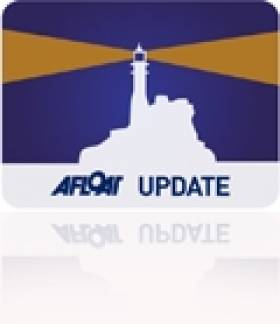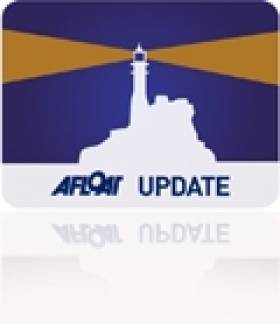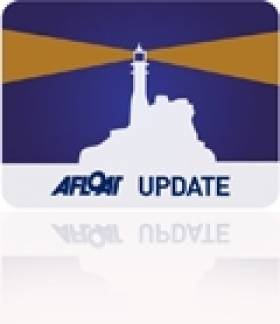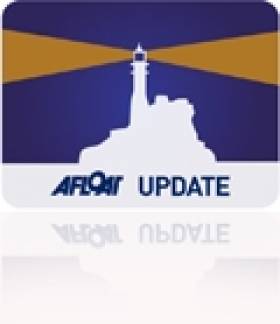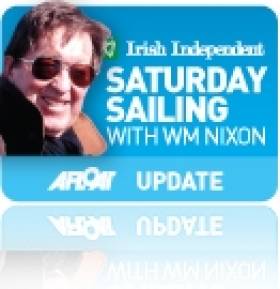Displaying items by tag: Fastnet
Kenefick & Sorensen Sign Up For Double–Handed Fastnet Race
#fullirish – David Kenefick sailing in his rookie year in the single handed Figaro fleet in his boat "The Full Irish" has teamed up with leading international Dragon sailor Olaf Sorensen from Kinsale to sail double handed in the forthcoming Fastnet race.
David finished the demanding multi-leg Figaro Race in 28th place, some 12 hours and 14 minutes behind the leader and third of the seven Rookies. Now in its 44th year and following Damian Foxall , Marcus Hutchinson and Paul O'Riain, 22–year–old David has become the fourth and youngest-ever Irish skipper to finish this legendary race. David has been involved in a gruelling training schedule in France since December 2012 under the tutelage of Marcus Hutchinson, the Irish offshore racer. David is a brother of the 2011 winner of the Irish Helmsman's Championships, George and has already acquired a reputation a leading inshore and offshore racing skipper and looks set to follow in the footsteps of Damian Foxall on the highly competitive international professional circuit.
The Figaro boats which are usually sailed singlehanded are stripped out uncompromising racing machines with absolutely no creature comforts with very basic facilities for preparing food. They are water ballasted to compensate for the lack of crew weight and can achieve amazing speeds downwind with their powerful rigs and large spinnakers.
For the biennial Fastnet race the Figaro boats must sail two handed to comply with ORC regulations and David looked to fellow Cork based sailor Olaf Sorensen to undertake this daunting challenge. It is a unique blend of age and experience. Olaf is an experienced small boat racer with a successful background in Flying Fifteens and Dragons. In recent years he was the most successful Irish Dragon racing in Europe achieving several notable wins and top 5 placings in large competitive fleets, including winning the Italian Nationals from a fleet of over 50 boats. Olaf has just completed a transatlantic crossing, delivering a 55–foot Jeanneau from Antigua to Gibraltar.
Last week the pair undertook training and familiarisation which included participation in what transpired to be predominantly a moderate airs Channel race. "The Figaro boats are unbelievably quick requiring 100% concentration all the time and they are very physical" was Olaf's initial assessment of his experience. In his late 50's, Olaf will be the oldest competitor sailing in a Figaro boat in the Fastnet race but he is confident his strict fitness regime will stand to him over the 5/ 6 days of the race. David on the other hand is looking forward to the extensive experience Olaf can contribute during such a long race and believe they will make a formidable albeit unusual team.
#fastnet – A key feature of this year's Rolex Fastnet Race will be the number of high profile women taking part, when the world's largest offshore race sets sail from Cowes on Sunday 11th August.
Yet again the Royal Ocean Racing Club's flagship event is breaking new records in terms of the size of its fleet with 372 boats entered at present. The biennial race from Cowes to the Fastnet Rock off southwest Ireland and back around the Scilly Isles to Plymouth, is now by far the biggest of all the international 600 mile offshore races.
The largest on the start line will be the 40m trimaran Spindrift 2, which as Maxi Banque Populaire in 2011 romped around the course in just 32 hours 48 minutes. As she was finishing most of the fleet had still to round Land's End en route to the Fastnet Rock. Since the last race, the fastest offshore boat in the world, which holds the record for the highest ever 24 hour run (908.2nm or 37.84 knots average) has been sold to the Franco-Swiss Spindrift racing team. Her new co-skippers are Yann Guichard and Dona Bertarelli, whose brother Ernesto Bertarelli twice won the America's Cup with his Alinghi team.
Spindrift is obviously gunning to beat the existing record of its new trimaran. However even with a good forecast this shouldn't be taken for granted.
"This race is a big challenge for me and for the Spindrift racing team as a whole, not only because of its historical importance, but for several other reasons," explains Bertarelli, who has spent the last years campaigning the D35 catamaran Ladycat in Switzerland. "The Rolex Fastnet Race will be my first offshore experience, but it will also be our first race with Spindrift 2. We are competitors and even though we will have had little time to train, to get to know the boat and build a strong sailing team, our objective remains to win."
Team SCA is competing in the Rolex Fastnet Race as part of the Swedish campaign's rigorous training regime and selection process to mount the Volvo Ocean Race's best ever all-female campaign. As part of their training regime, they typically sail their VO70 training boat - formerly Puma Ocean Racing's mar mostro - with their male coaches on board. For the Fastnet this will comprise multiple Volvo Ocean Race winner Brad Jackson, Joca Signorini and Spanish bowman Pepe Ribes. Among the British crew is Vendee Globe skipper Sam Davies and Olympic match racer Annie Lush, two of the five women already selected for the team.
For Davies this will be her fifth Rolex Fastnet Race, having last competed with Sidney Gavignet aboard the IMOCA 60 Artemis Ocean Racing in 2009. On board she is navigator although as she points out "we are all in the watch system, so I will be sailing and navigating."
Team SCA is at present one of four VO70s competing, up against the Ian Walker-skippered Abu Dhabi, which set a monohull course record in 2011, plus the former Team Russia and the latest entry, Camper, being campaigned by an Australian crew led by TP52 owner Jason van der Slot.
How do Team SCA expect to get on against Abu Dhabi? "We have done a lot more sailing, but we are missing the Volvo experience still. I'm sure their crew will be made up mostly of people who have done the race before."
Likely to finish between Team SCA and Spindrift 2 will be another Vendee Globe competitor, Dee Caffari.
For Caffari this will be her seventh Fastnet, her first having been as skipper of the Challenge boat Group 4 in 2001. In 2007, her IMOCA 60 Aviva had to pull out with a ripped mainsail and a very sick quadruple Olympic gold medallist Matthew Pinsent on board, while last year she received her multihull baptism, hitching a ride on Steve Ravussin's MOD70, Race for Water.
"I'd never done the race that quick before in my life, so I am really delighted I'm back on a MOD70," says Caffari, who this year joins Sidney Gavignet's team on Oman Air-Musandam.
As part of Oman Sail's continued efforts to develop women's sailing in the sultanate, Omani sailor Raya Al Habsi will also be competing on board. She has previously competed in Sailing Arabia-The Tour in 2012 and 2013, and is currently part of the all-female Oman Sail entry at the J/80 Worlds. "Raya has been with us from the beginning of the girls' offshore sailing," says Caffari. "She has been working the bow on the Farr 30 and has been cold, wet and beaten up and still continues to smile, which is a good characteristic to have for a tough environment, which the Fastnet is. This is big deal for Oman Sail and for Arab women in sport."
As to their prospects this year Oman Air-Musandam will be up against another MOD70 in the Seb Josse-skippered Edmond de Rothschild. Caffari remembers two years ago when they match raced another MOD70 Veolia Environnement for the entire race. "I am really looking forward to being back in that intensity again."
Some way behind the grand prix speedsters will be another all-female team led by Lucy Reynolds. While husband Christian Reynolds will be campaigning the Swan 53 Northern Child, Lucy has entered the First 40, Southern Child. "One of our regular crew asked if I'd be interested in doing an all-female campaign and I went 'why not?'" says Lucy of how this came about. The Reynolds run a charter company and the crew of Southern Child is mostly paying guests.
"One of our crew has done the race before and another has done the ARC and various transatlantic and offshore passage, so it is a mixed level of experience, and we have a couple coming in from the States," says Lucy.
To date they have had a training weekend and competed in the RORC's Morgan Cup and have the St Malo and Channel Races ahead of them to build up their experience and qualification miles.
"It has been very enjoyable, everyone just growing and learning," explains Lucy for whom this will be her third Rolex Fastnet Race. "Quite often with female sailors, they do a task and they don't understand why they are doing it. So it has been a really enjoyable process empowering people to do things for themselves and understand why they are doing it."
At present there are six First 40s competing in IRC 2 and given that two, La Réponse and Lancelot 2 Logic finished just nine seconds apart on corrected time in the RORC's recent Morgan Cup, they can expect some close racing.
Plymouth Gets Set to Welcome Fastnet Race Competitors
#fastnet – Plymouth is gearing up to welcome thousands of sailors from all corners of the globe in the Royal Ocean Racing Club's celebrated Rolex Fastnet Race. Now in its 45th edition the biennial race, which started in 1925, features on every seasoned sailor's 'must do' list as well as newcomers seeking a tough personal challenge. Drawn by the history and sporting lure of Europe's oldest and greatest offshore contest, it is legendary within the world of ocean racing.
The 2013 race has already set new records before it's even started: up to 380 boats from over 20 countries, from as far afield as Australia, Russia, America and Lithuania, will converge on the historic maritime City of Plymouth for the finish of the 608 nautical mile race which sets off from Cowes, Isle of Wight on Sunday 11th August.
The race which sees the mammoth fleet round the iconic Fastnet Rock before heading to the finish, showcases the most diverse range of yachts imaginable; from 30ft to 130ft and attracts aspiring sailors to professional crews who race all over the world. Accommodating the largest ever Fastnet fleet and around 3,500 competitors has been made possible by the move to Mount Batten's Plymouth Yacht Haven.
"Plymouth Yacht Haven, Mount Batten has the capacity to supply the extra berthing that is needed in this record breaking year. With so much demand, we had to find a solution and moving the event to Plymouth Yacht Haven and working with Queen Anne's Battery, Sutton Harbour and Mayflower marinas will give us the capacity we need to berth a fleet of this size and provide the facilities expected by the sailors," says Royal Ocean Racing Club's CEO, Eddie Warden Owen.
Also new for 2013 will be the Acoustic Circus in the Race Village, providing top entertainment each afternoon from Tuesday 13th through to Friday 16th August and luckily for those competing, the finish of the race coincides with the British Fireworks Championships, so it is set to be a spectacular week for both visitors, locals and the yachtsmen alike.
#isora – Preparing for the offshore racing season and especially the Dun Laoghaire to Dingle race and Fastnet Race is the subject of Wednesday's pre-season ISORA talk at the National Yacht Club on Wednesday at 7pm. 'Prof' O'Connell of North Sails Ireland will talk about "Offshore Trim and Speed" and Mick Liddy will talk about "Offshore Tactics and Navigation".
There will be a wine reception afterwards.
RORC Increases Fastnet Fleet Size
#fastnet – With the entry limit of 300 filled within 24 hours, over 100 boats on the waiting list and entries from multihulls, IMOCA 60s and Class 40s still coming in, demand for places in this year's Rolex Fastnet Race have been greater than ever. To answer this unprecedented demand the RORC has decided to increase the number of places available for IRC rated boats by an extra 40 places, to 340. The addition of multihulls, IMOCAs, Class 40s and Mini Transats could easily bring the total fleet to 380 boats and to cope with this the club has decided to move the event to Plymouth Yacht Haven which has the capacity to supply the extra berthing that is needed.
"With so much demand we had to find a solution and moving the event to Plymouth Yacht Haven and working with Queen Anne's Battery, Sutton Harbour and Mayflower marinas should give us the capacity we need to berth a fleet of this size and provide the facilities expected by over 3000 sailors" says RORC CEO, Eddie Warden Owen.
Plymouth Yacht Haven has capacity for 450 berths, is accessible at all tides and has comprehensive facilities to satisfy the requirements of the competitors, organisers and sponsors. It will host the Rolex Fastnet Race Village where spectators can mingle with sailing superstars and enjoy live music and a variety of activities.
In 2011 the RORC committee removed the "pro sailed boats" such as Volvo 70s, IMOCAs and Class 40s from the 300 entries to release nearly 30 places for IRC rated boats on the waiting list who are the only boats eligible to win the main trophy, the Fastnet Challenge Cup
Commenting on the increase in fleet size RORC Commodore Mike Greville says: "The 300 limit has its origins in the inquiry following the 1979 race, but advancements in all aspects of the sport including yacht design, boatbuilding, and navigation equipment have dramatically improved its safety. The race also has a qualification process to ensure that the crew have sufficient experience in the boat they are racing before they are accepted as an entry. Following the unprecedented level of interest in this year's event we have moved to reconsider the limit but, before making any decision, we had to work out what was deliverable and this required us to move the event to Plymouth Yacht Haven."
Starting from Cowes, Isle of Wight on 11th August, yachts will arrive in Plymouth between 13th and 17th August at the end of what can be a very challenging offshore race.
Rock Breaking Records
#fastnet – Why are people surprised that, despite the international mood of economic gloom, online entries for the Rolex Fastnet Race 2013 in August went through the roof earlier this week, with the ceiling of 300 boats – nine of them Irish - hit in record time, well within 24 hours of the lists opening, with the first one in just seven seconds after the gun fired?
Fact is, the Fastnet is incredibly good value for money for ordinary offshore sailors based along either side of the English Channel, and on both coasts of the southern North Sea. It's set up on a plate ready-to-go, its start and finish are within convenient sailing distance of them all, yet it's an event of historic and almost mythic global status, made even more so by the disastrous storm of 1979.
To have it in your sailing CV, regardless of where you place at the finish, is still something which mightily impresses non-sailing colleagues at work, and down the pub too if you live more than half a dozen miles from the sea. Yet taking part in it is no big deal financially for the English Channel/Southern North Sea sailors when you factor in the enormous number of existing boats which are well capable of doing it.
If we set aside the original cost of the boat by regarding that transaction as history and not part of the new financial equation, thanks to today's much more rigorous inter-governmental safety and equipment standards, it's not too onerous to bring an ordinary production performance cruiser up to the RORC requirements.
So taking the existence and ownership of the boat as a given, what is needed is enthusiasm, energy, the availability of shipmates, and that precious place in the entry list. It's a setup which suits Offshore Sailing Schools very well indeed – they made extra sure of securing their entries, and are pushing above 10% of the total list. As for private owners, for some nowadays the entry place seems to have become top of the priorities, and people are securing their slot in the hope of then putting their campaign together on the basis of this essential building block. Either way, there's already a waiting list, but it can activate into entry acceptance remarkably quickly, even if some secured entries hang on until the last minute, days after it's clear they'll be no-shows.
Back in 2007, one of Ireland's greatest offshore skippers, Ger O'Rouke of Limerick, was campaigning his Cookson 50 Chieftain with enormous vigour, and in June/July he raced the Transatlantic from New York to Hamburg. But he had an understandable superstition about finalizing his entry for the next big race before finishing the race of the moment, and thus when Chieftain got into Hamburg, she may have won her class and placed second overall, but as far as the Fastnet Race 2007 was concerned, she was still only No 46 on the waiting list.
But Ger took her down to the Solent, and based himself in the Hamble to be near the scene of the action, making sure the Fastnet race office knew he was there and ready to go, so that as places became available from the waiting list, the over-worked race officers could be sure that one boat at least was a certain substitute. Meanwhile he was also keeping an eye on other boats in uncertain pre-Fastnet mode around the Hamble, because after the time-consuming Transatlantic campaign, Ger was a bit short of crew, and he was quietly sussing out Fastnet hopefuls to make up his numbers if he got the call.
Less than 48 hours before the race was due to start, Chieftain was in. So in terms of accepted boat management practice, you might say she was a last minute entry, with her crew numbers completed by pierhead jumpers. Having cleared the acceptance hurdle, they frustratingly couldn't get racing right away, as the start was postponed for a day because of a Force 9 south'wester. Even when it did get going in quite a rugged slug to windward down the English Channel, something like 150 boats soon retired.
But Chieftain was loving it, though even before she'd bashed her way past the Lizard, all the installed electronics crashed. They navigated the rest of the race with a little handheld GPS and a few wet and disintegrating paper charts. Not to worry, they had a hugely acclaimed overall win, the first ever by an Irish boat, and Ger O'Rourke was Ireland's Sailor of the Year 2007. Not bad going for a last-minute entry crewed by pierhead jumpers.
With stories like this cascading down the years, it's little wonder the Fastnet is something special. And though it involves a little more effort for Irish boats to get to the start, it's still a mega-happening within easy reach, tantalizingly so when rounding the rock itself. Thus although we've only managed a sneak preview of the initial entry list, and while accepting that some may fall by the wayside because of rigorous crew requirements further down the lines, nevertheless the news is it's good news, Ireland has a quality entry, and there'll be much more to it than simply having the Fastnet Race in the old sailing CV.
In alphabetic order, they're Alchimiste (JPK 9.60, Mike Murphy), Antix (Ker 39, Anthony O'Leary), David Kenefick Sailing (Figaro II, Marcus Hutchinson), Jedi (J/109, Andrew Sarratt) Joker (J/109, Chris Andrews), Lula Belle (First 36.7, Liam Coyne), Lynx Clipper (Reflex 38, Aodhan Fitzgerald), Raging Bull (Sigma 400, Matt Davis) and Spirit of Jacana (J/133, Andrew, Bruce & James Douglas).
At least three other boats have special Irish interest – Nick Martin's J/105 Diablo-J, currently RORC Yacht of the Year after winning the two-handed championship including the double handed division in the round Ireland, with Dun Laoghaire's Andrew Boyle signed on to crew again, and the two recent round Ireland winners - Laurent Gouy's Ker 39 Inis Mor, and Piet Vroon's Ker 46 Tonnere de Breskens.
Of the directly Irish boats, we note that the O'Leary family's Antix – a sister-ship of Inis Mor – has never done a major long offshore race before, not even the Round Ireland, but she's has won oodles of stuff round the cans and in shorter offshores, so her transference to the wide open spaces will be interesting. Further down the line, Lynx Clipper entered by Aodhan Fitzgerald is of course NUI Galway, the Reflex 38 which is current ICRA Boat of the Year. And it's good to see Matt Davis's successful Sigma 400 Raging Bull (ISORA Champion 2011) back in the lists – she missed 2012 completely through coming ashore in Skerries in a nor'east gale in May, but has now been restored by Noonan Boats down Wicklow way.
Young David Kenefick's Figaro programme under the tutelage of Marcus Hutchinson will be well under way by Fastnet time, and this should provide useful publicity and unmatchable experience. As for the hot J/109s of Dublin Bay, two of them – Jedi and Joker – have made the cut, while their bigger sister, the Douglas brothers' J/133 Spirit of Jacana from Carrickfergus, is back again to defend her position as top-placed Irish boat in 2011. Smallest of all the Irish entries is Mike Murphy's JPK 9.60 Alchimiste – at 31ft she has one of the shortest overall lengths in the entire fleet, but with her beam upwards of 11ft she's a big-hearted little 'un, an impressive French creation.
We don't know at this stage which Irish boats are on the waiting list, but as it is that's a good solid lineup, with some welcome surprises. Looking at the fleet overall, defender Ran (JV 72, Niklas Zennstrom) is going again, as too is mono-hull record holder, the Volvo 70 Abu Dhabi (Ian Walker). There's a notable absence of American boats this time round (though their successful JV 72 Bella Mente is in the hunt), but we should bear in mind that the next Rolex Fastnet, in 2015, will coincide with the Bi-Centenary of the Royal Yacht Squadron, so we can expect the New York Yacht Club to be leading a formidable expeditionary force to events around that, including the Fastnet Race.
And looking beyond that, it's not too long to the Tri-Centenary of the Royal Cork in 2020. For Royal Cork's Quarter Millennium in 1970, they made it a two year event to accommodate American boats planning to take in the 1969 Fastnet. Doubtless plans are already well in hand to do that again with the Rolex Fastnet Race of 2019.........Put it in your diary now.
GLORIOUS GALATEA AND HAPPY HENN
There was some scepticism about last week's piece about Ireland's first America's Cup Challenger in 1886. Not as to whether it had taken place – it's quite clear in the America's Cup records that in 1886, Lt William Henn had challenged through the Royal Northern Yacht Club with his new cutter Galatea. No, the disbelief was about the notion that Lt Henn and his supportive wife and their crew (including Peggy the pet monkey) had lived aboard Galatea, which stayed on in America in order to challenge again the following Spring, as Henn reckoned the Autumn breezes off Marblehead were too light.
We've since unearthed this antique photo of Galatea's main saloon, which would suggest that you could have lived aboard the big steel cutter in rather more luxurious comfort than the Henn family's many tenants would have enjoyed in their small farms along the north shore of the Shannon Estuary. But in terms of America's Cup racing potential, it tells us why Galatea was just about as effective as a Shannon gandolow in taking on the American defender Mayflower, an Edward Burgess designed 100ft cutter which won every race whether Autumn or Spring, the biggest margin being a whopping 29 minutes and 9 seconds.
Yet today the fascination is with Galatea's extraordinary saloon, which seems to have at least two leopardskin rugs, and a proper fireplace – absolutely essential in any proper racing yacht. As to William Henn retaining his modest naval title of Lieutenant, it seems that he took early retirement from the Royal Navy in order to go sailing, his personal fortune being sufficient to do so, and he was so keen on sailing the sea that before Galatea was built on the Clyde in 1885, he lived aboard his previous yacht for seven years.
At the time of his challenge, the American press commented on "this retired Naval Officer with his rich Irish charm", while his gallant wife seems to have been Scottish, hence his challenge through the Royal Northern YC, and other links to the Clyde. This makes it unlikely that the remains of Galatea can be found (as is popularly supposed) in the Fergus estuary on the north shore of the Shannon estuary, off the remains of Paradise which was the old Henn house. According to Lloyd's Register of 1910, Mrs Henn is still listed as owning Galatea, but is now apparently a widow, and resident on the Isle of Bute, while Galatea is listed as being in proper order, but having her base at Port Glasgow.
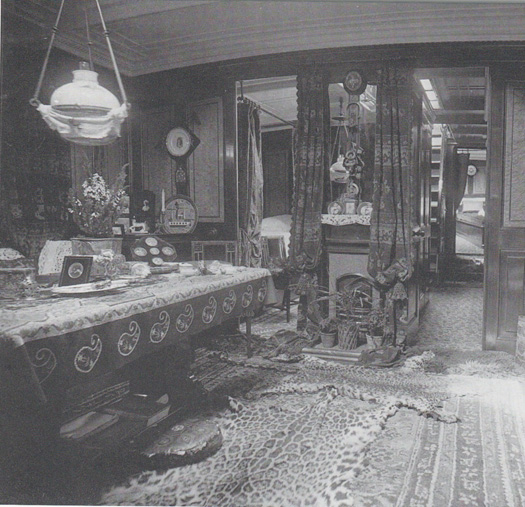
The main saloon on the Irish-owned 1886 America's Cup challenger Galatea provided all comforts and catered for every possible need, except the needs of a racing boat.
#kinsale – A final 20-minute postponement did little to deter the hardy crews who came out last Friday evening to do battle in the already twice postponed Kinsale Fastnet race, sponsored by CH Marine writes Peadar Murphy. In what is now deemed seasonably gusty and lumpy conditions, just three boats made it out to take on the challenge of this overnight offshore classic – but it was definitely a case of quality, not quantity his year. Long-time offshore rivals Tom Roche on Meridian and Tony O'Brien's White Tiger squared off against each other again, with Olaf Sorensen's Dianna keeping them both honest.
The three ships headed off to the renowned waypoint initially in the lee of the Old Head, but soon were experiencing the lumpy sees that would test the perseverance and sea legs of many in the race. With 12 aboard, White Tiger had plenty weight on the rail and was able to overhaul less populous Meridian on the long tack out past the Old Head, in conditions that would normally have been advantageous to Roche's Salona 45. About two miles south of the Old Head, Meridian tacked onto port and west into Courtmacsherry Bay, having been overhauled by O'Brien's Beneteau 44.7, which continued south for another three miles. Dianna also went for the offshore option hoping to stay out of the tide.
As darkness fell, Meridian and White Tiger crossed a number of times off the Seven Heads, the Galley and south of High Island off Glandore. Meridian initially regained her lead, but O'Brien's crew, featuring a number of seasoned Fastnet campaigners, gradually reeled her in again. On the tack south to clear the Stag Rocks' cardinal buoy, White Tiger pounced in the patchy wind that had been backing all night, as forecasted, and soon stretched out into a comfortable lead.
White Tiger called in her rounding of the Fastnet to Bantry Radio soon after 04:50. The long beat down in the sloppy seas and the leaden skies meant there were few requests for what would normally be the obligatory souvenir photos with the legendary lighthouse in the background. Meridian rounded less than 20 minutes later and both ships soon had kites flying, and crews appreciating the relative comfort that came with running with the swell. Dianna called in her rounding within an hour of Meridian – a remarkable achievement considering that she was crewed by just three hardy souls, some of whom were distinctly under the weather!
Meridian opted to go offshore as a way to sail a hotter angle and possibly pick up a flyer, but the White Tiger team, which in last year's race had given up a lead of almost an hour to Meridian at this stage of the race, were alert to the move, and changed up to their masthead runner. Some excellent sailing was experienced by all on the leg back to Kinsale, with White Tiger never quite managing to break the 11-knot barrier despite some determined efforts to get her to surf past that threshold. Not to be outdone, Dianna also flew a kite – a fine display of short-handed seamanship in the conditions.
Interestingly, both Meridian and White Tiger will be sending torn kites to the sailmakers this week, with various manoeuvres going awry. However, as she headed for the finish line off Charles Fort White Tiger was well clear of Meridian, crossing the finish line at 10:23 after 14 hours 8 minutes of racing, with Meridian coming home just over 17 minutes adrift. Less than two hours after that Dianna glided past the Bostoon Buoy in Kinsale to close out the race.
Nick Bendon of CH Marine was on hand Sunday evening at the prize-giving which were received with great bonhomie by the skippers and crews. In both IRC and ECHO the finishing places reflected on the water placings, with White Tiger claiming the magnificent Fastnet trophy for the winner in ECHO, along with the cup for fastest boat in IRC. Meridian took second place in both divisions, with the determined Sorensen team coming home in a very respectable third.
The annual Cork Cruise sponsored by the Glendinning family takes place this coming Saturday with first gun at 10:25.
Lifeboats Receive 1,000 Calls for Help in 2011
#LIFEBOATS – RNLI Lifeboats in Ireland launched 980 times to a variety of call outs in 2011. 905 people were rescued over the course of the year by volunteer lifeboat crews who spent over 9,826 hours on service at sea.
Howth RNLI lifeboat station in Dublin was the busiest coastal Irish station, launching to 48 requests for help and, bringing 60 people to safety. They were followed by Crosshaven RNLI in Cork who launched 46 times and assisted 43 people. Enniskillen, one of Ireland’s two inland RNLI lifeboat stations which operates bases on both Upper and Lower Lough Erne, launched 52 times and brought 46 people to safety.
The busiest month for rescues was July with 155 launches followed by August with 124 calls for assistance. February 2011 was the busiest February for Irish launches in the RNLI’s history, as were May and October 2011.
Over a third of the RNLI’s call outs for last year were also carried out in darkness. The statistics show that launches to vessels suffering machinery failure still account for the largest number of call outs (187) followed by vessels reported to be in trouble (78), grounded (74) and capsizing (73).
Commenting on the 2011 statistics RNLI Deputy Divisional Inspector Gareth Morrison said: ‘Our lifeboat volunteers continue to show selfless dedication and commitment to saving lives. Some stations are extremely busy while others have less call outs but spend long hours at sea in awful conditions. There were some outstanding rescues last year including that to Rambler 100, in which Baltimore RNLI recovered 16 crew members off the upturned hull of the racing boat during the Fastnet race. Sadly there were also long searches for missing loved ones.
‘The work of the volunteer lifeboat crews could not be made possible without the generosity of the public who in difficult times continue to support Irish lifeboat crews. While these figures give an interesting insight into search and rescue by the RNLI on Irish waters they are by no means the full story. As well as working to save lives at sea the RNLI provides other programmes and services for the public including sea safety advice and clinics, education roadshows and visits to lifeboat stations.’
The 2011 figures are being released in the wake of the RNLI Lifejackets for Lifesavers campaign which will see every lifeboat station in Ireland take delivery of new specially designed lifejackets in September. The lifejackets have been commissioned by the RNLI for search and rescue work and have been given the seal of approval from lifeboat volunteers. The cost of providing the lifejackets for all 43 lifeboat stations in Ireland is estimated at €160,000.
Wogan's Visit to Cape Clear Island
#ISLANDS - Cape Clear Island's most well-known couple may get even wider attention now that they're featured in Terry Wogan's new book on Ireland.
Micheál and Sile Ó Ceadagáin – who were the focus of TG4 programme Mí na Meala – are two of the many characters included in Wogan's Ireland, the book accompanying the legendary broadcaster's recent TV series.
According to the blog of the Cape Clear ferry service Cailín Óir: "The photographs [included] are stunning, including those of Cléire and Fastnet, to where Terry enjoyed an idyllic summer’s outing with Micheál on his boat The Gaisceannán.
"Micheál and Sheila are a hospitable couple which extends to the boat and Micheal's famous teas served at sea have pleased many, including the indefatigable Terry."
Wogan's Ireland is packed with photos and stories of Terry's whistle-stop tour of the country's 'coastal fringe', laced with his self-deprecating wit. The book is available online for as little as €10.
Kieran Cotter and Jerry Smith Named Sailors of the Month for August
When Rambler's canting keel snapped off on the evening of Monday August 15th shortly after this mega-machine had rounded the Rock, she was powering at full speed towards the turning buoy, crashing into the lumpy seas which often arise where the steep land juts into the open ocean.

Kieran Cotter and the crew of the Baltimore lifeboat at the capize site. Photo: Thierry Martinez
The catastrophe was total and very sudden. The giant racer completely inverted every bit as quickly as the smallest of racing dinghies. The changeover, from being a highly tuned performer on track for success, into the inverted hell of exploding water, strangling ropes and jagged breaking gear, was at the least totally disorienting, and could have caused panic in less seasoned sailors.

The Lifeboat rescue from the upturned hull. Photo: Team Phaedo
Despite the difficulty of clambering onto the ultra-smooth underside of the huge hull, fifteen of the crew managed to get themselves up to the minimal handhold of the dagger board. But five of those who had been below – some of them off watch asleep – had drifted away from the boat after the monumental struggle of escaping from a small world turned upside down.
The five in the water roped themselves together, but things had taken an ominous turn, as the mist in which the big boat had rounded the Fastnet had now thickened into fog. For a crucial period, visibility was virtually nonexistent as other boat raced past nearby at high speed. And although some emergency radio beacons had automatically activated, the picture was confused with night drawing on.

Drifting crew are rescued. Photo: Team Phaedo
Time was of the essence – even in summer these waters can quickly induce hypothermia. Several agencies were now involved in the rescue, and skilled use of technology narrowed the search area, though in the sea conditions the stricken boat and crew were frequently invisible.
It was the Baltimore lifeboat with Kieran Cotter in command which was first on the scene. Taking off the crew was a challenge, but all fifteen on the upturned Rambler were safely rescued, though an impact between lifeboat and white hull resulted in a streak of lifeboat blue on the yacht which was to be immortalised as "Kieran's kiss".
But that was later, not until after a needle-in-a-haystack search found the other five adrift together in the water, with one already on the edge of coma. They were found by the lifeboat deputy mechanic Jerry Smith, on patrol with a Fastnet Race film crew in his dive boat Wave Chieftain. It was a miracle.
Next morning safely in Baltimore, the weather was already well improved. The previous night's conditions seemed like a nightmare. In calm summery conditions two days later, the Rambler hull was righted off Barley Cove and towed to Baltimore. She'll be restored to full racing trim by Cookson's in New Zealand, presumably with modifications to the design and specification for the canting keel. But that's another day's work. Today, we celebrate the achievement of Kieran Cotter and Jerry Smith, whose seamanship provided the successful focus for a network of rapid work by skilled technologists ashore.
Coverage of the rescue appears in Afloat's Rolex Fastnet Race page




























